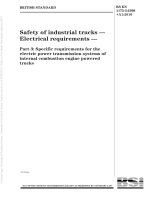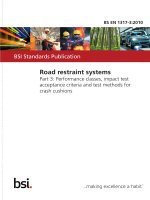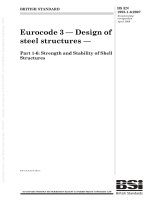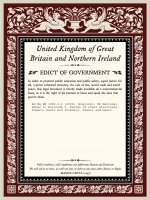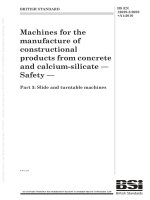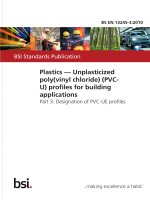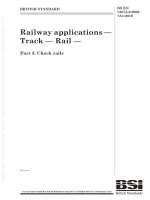Bsi bs en 61784 3 6 2010
Bạn đang xem bản rút gọn của tài liệu. Xem và tải ngay bản đầy đủ của tài liệu tại đây (1.77 MB, 92 trang )
BS EN 61784-3-6:2010
BSI Standards Publication
Industrial communication
networks — Profiles
Part 3-6: Functional safety fieldbuses —
Additional specifications for CPF 6
NO COPYING WITHOUT BSI PERMISSION EXCEPT AS PERMITTED BY COPYRIGHT LAW
raising standards worldwide™
BS EN 61784-3-6:2010 BRITISH STANDARD
National foreword
This British Standard is the UK implementation of EN 61784-3-6:2010.
It is identical to IEC 61784-3-6:2010. It supersedes BS EN
61784-3-6:2008 which is withdrawn.
The UK participation in its preparation was entrusted to Technical
Committee AMT/7, Industrial communications: process measurement
and control, including fieldbus.
A list of organizations represented on this committee can be
obtained on request to its secretary.
This publication does not purport to include all the necessary
provisions of a contract. Users are responsible for its correct
application.
© BSI 2010
ISBN 978 0 580 72030 7
ICS 25.040.40; 35.100.05
Compliance with a British Standard cannot confer immunity from
legal obligations.
This British Standard was published under the authority of the
Standards Policy and Strategy Committee on 30 September 2010.
Amendments issued since publication
Date Text affected
EUROPEAN STANDARD EN 61784-3-6
NORME EUROPÉENNE
EUROPÄISCHE NORM August 2010 Supersedes EN 61784-3-6:2008
ICS 25.040.40; 35.100.05 English version
Industrial communication networks -
Profiles -
Part 3-6: Functional safety fieldbuses -
Additional specifications for CPF 6
(IEC 61784-3-6:2010)
Réseaux de communication industriels - Industrielle Kommunikationsnetze -
Partie 3-6: Bus de terrain à sécurité Profile -
fonctionnelle - Teil 3-6: Funktional sichere Übertragung
Spécifications complémentaires bei Feldbussen -
pour le CPF 6 Zusätzliche Festlegungen
(CEI 61784-3-6:2010) für die Kommunikationsprofilfamilie 6
(IEC 61784-3-6:2010)
This European Standard was approved by CENELEC on 2010-07-01. CENELEC members are bound to comply
with the CEN/CENELEC Internal Regulations which stipulate the conditions for giving this European Standard
the status of a national standard without any alteration.
Up-to-date lists and bibliographical references concerning such national standards may be obtained on
application to the Central Secretariat or to any CENELEC member.
This European Standard exists in three official versions (English, French, German). A version in any other
language made by translation under the responsibility of a CENELEC member into its own language and notified
to the Central Secretariat has the same status as the official versions.
CENELEC members are the national electrotechnical committees of Austria, Belgium, Bulgaria, Croatia, Cyprus,
the Czech Republic, Denmark, Estonia, Finland, France, Germany, Greece, Hungary, Iceland, Ireland, Italy,
Latvia, Lithuania, Luxembourg, Malta, the Netherlands, Norway, Poland, Portugal, Romania, Slovakia, Slovenia,
Spain, Sweden, Switzerland and the United Kingdom.
CENELEC
European Committee for Electrotechnical Standardization
Comité Européen de Normalisation Electrotechnique
Europäisches Komitee für Elektrotechnische Normung
Management Centre: Avenue Marnix 17, B - 1000 Brussels
© 2010 CENELEC - All rights of exploitation in any form and by any means reserved worldwide for CENELEC members.
Ref. No. EN 61784-3-6:2010 E
BS EN 61784-3-6:2010
EN 61784-3-6:2010 - 2 -
Foreword
The text of document 65C/591A/FDIS, future edition 2 of IEC 61784-3-6, prepared by SC 65C, Industrial
networks, of IEC TC 65, Industrial-process measurement, control and automation, was submitted to the
IEC-CENELEC parallel vote and was approved by CENELEC as EN 61784-3-6 on 2010-07-01.
This European Standard supersedes EN 61784-3-6:2008.
The main changes with respect to EN 61784-3-6:2008 are listed below:
– updates in relation with changes in EN 61784-3.
Attention is drawn to the possibility that some of the elements of this document may be the subject of
patent rights. CEN and CENELEC shall not be held responsible for identifying any or all such patent
rights.
The following dates were fixed:
– latest date by which the EN has to be implemented (dop) 2011-04-01
at national level by publication of an identical
national standard or by endorsement
– latest date by which the national standards conflicting (dow) 2013-07-01
with the EN have to be withdrawn
Annex ZA has been added by CENELEC. __________
- 3 - BS EN 61784-3-6:2010
EN 61784-3-6:2010
Endorsement notice
The text of the International Standard IEC 61784-3-6:2010 was approved by CENELEC as a European
Standard without any modification.
In the official version, for Bibliography, the following notes have to be added for the standards indicated:
EN 50170
IEC 61131-2 NOTE Harmonized as EN 61131-2.
IEC 61326-3-1 NOTE Harmonized as EN 61326-3-1.
IEC 61326-3-2 NOTE Harmonized as EN 61326-3-2
IEC 61496 series NOTE Harmonized in EN 61496 series (partially modified).
IEC 61508-1:2010 NOTE Harmonized as EN 61508-1:2010 (not modified).
IEC 61508-4:2010 NOTE Harmonized as EN 61508-4:2010 (not modified).
IEC 61508-5:2010 NOTE Harmonized as EN 61508-5:2010 (not modified).
IEC 61508-6:2010 NOTE Harmonized as EN 61508-6:2010 (not modified).
IEC 61784-5 series NOTE Harmonized in EN 61784-5 series (not modified).
IEC 61800-5-2 NOTE Harmonized as EN 61800-5-2.
ISO 10218-1 NOTE Harmonized as EN ISO 10218-1.
ISO 13849-2 NOTE Harmonized as EN ISO 13849-2.
__________
BS EN 61784-3-6:2010
EN 61784-3-6:2010 - 4 -
Annex ZA
(normative)
Normative references to international publications
with their corresponding European publications
The following referenced documents are indispensable for the application of this document. For dated
references, only the edition cited applies. For undated references, the latest edition of the referenced
document (including any amendments) applies.
NOTE When an international publication has been modified by common modifications, indicated by (mod), the relevant EN/HD
applies.
Publication Year Title EN/HD Year
IEC 60204-1 - -
IEC 61131-3 - Safety of machinery - Electrical equipment of EN 60204-1 -
IEC 61158 Series machines - Series
IEC 61158-2 - Part 1: General requirements -
IEC 61158-3-8 - Programmable controllers - EN 61131-3 -
Part 3: Programming languages
IEC 61158-4-8 - -
Industrial communication networks - EN 61158
IEC 61158-5-8 2007 Fieldbus specifications 2008
IEC 61158-6-8 - Industrial communication networks - EN 61158-2 -
IEC 61508 Series Fieldbus specifications - Series
IEC 61511 Series Series
IEC 61784-1 - Part 2: Physical layer specification and service -
IEC 61784-2 - -
definition
Industrial communication networks - EN 61158-3-8
Fieldbus specifications -
Part 3-8: Data-link layer service definition -
Type 8 elements
Industrial communication networks - EN 61158-4-8
Fieldbus specifications -
Part 4-8: Data-link layer protocol specification
- Type 8 elements
Industrial communication networks - EN 61158-5-8
Fieldbus specifications -
Part 5-8: Application layer service definition -
Type 8 elements
Industrial communication networks - EN 61158-6-8
Fieldbus specifications -
Part 6-8: Application layer protocol
specification - Type 8 elements
Functional safety of EN 61508
electrical/electronic/programmable electronic
safety-related systems
Functional safety - Safety instrumented EN 61511
systems for the process industry sector
Industrial communication networks - Profiles - EN 61784-1
Part 1: Fieldbus profiles
Industrial communication networks - Profiles - EN 61784-2
Part 2: Additional fieldbus profiles for real-time
networks based on ISO/IEC 8802-3
- 5 - BS EN 61784-3-6:2010
EN 61784-3-6:2010
Publication Year Title EN/HD Year
IEC 61784-3 2010 2010
IEC 61784-5-6 - Industrial communication networks - Profiles - EN 61784-3 -
IEC 61918 - Part 3: Functional safety fieldbuses - General -
IEC 62061 - rules and profile definitions -
ISO 12100-1 - -
ISO 13849-1 - Industrial communication networks - Profiles - EN 61784-5-6 -
Part 5-6: Installation of fieldbuses - Installation
profiles for CPF 6
Industrial communication networks - EN 61918
Installation of communication networks in
industrial premises
Safety of machinery - Functional safety of EN 62061
safety-related electrical, electronic and
programmable electronic control systems
Safety of machinery - Basic concepts, EN ISO 12100-1
general principles for design -
Part 1: Basic terminology, methodology
Safety of machinery - Safety-related parts EN ISO 13849-1
of control systems -
Part 1: General principles for design
This page deliberately left blank
–4– BS EN 61784-3-6:2010
61784-3-6 © IEC:2010(E)
CONTENTS
0 Introduction ......................................................................................................................9
0.1 General ...................................................................................................................9
0.2 Patent declaration .................................................................................................11
1 Scope............................................................................................................................. 12
2 Normative references .....................................................................................................12
3 Terms, definitions, symbols, abbreviated terms and conventions .................................... 13
3.1 Terms and definitions ............................................................................................13
3.1.1 Common terms and definitions ..................................................................13
3.1.2 CPF 6: Additional terms and definitions .....................................................18
3.2 Symbols and abbreviated terms............................................................................. 18
3.2.1 Common symbols and abbreviated terms .................................................. 18
3.2.2 CPF 6: Additional symbols and abbreviated terms ..................................... 19
3.3 Conventions ..........................................................................................................20
4 Overview of FSCP 6/7 (INTERBUS™ Safety) ................................................................. 20
4.1 General .................................................................................................................20
4.2 Technical overview................................................................................................20
4.3 Functional Safety Communication Profile 6/7......................................................... 21
5 General .......................................................................................................................... 22
5.1 External documents providing specifications for the profile ....................................22
5.2 Safety functional requirements ..............................................................................22
5.3 Safety measures ...................................................................................................22
5.3.1 General .....................................................................................................22
5.3.2 Sequence number .....................................................................................23
5.3.3 Time stamp ...............................................................................................23
5.3.4 Time expectation .......................................................................................23
5.3.5 Acknowledgement .....................................................................................23
5.3.6 Connection authentication .........................................................................23
5.3.7 Distinction between safety relevant messages and non-safety
relevant messages – different data integrity assurance system.................. 24
5.3.8 Parameterized shutdown time....................................................................24
5.4 Safety communication layer structure ....................................................................24
5.4.1 Decomposition process..............................................................................24
5.4.2 Definition of the safety function of the safety communication system ......... 25
5.4.3 Decomposition of the safety function of a safety communication
system into function blocks........................................................................ 26
5.4.4 Assignment of the function blocks to subsystems ...................................... 27
5.4.5 Safety requirements and safety integrity requirements............................... 30
5.4.6 Specification of the safe state....................................................................30
5.4.7 Response to a fault ...................................................................................31
5.4.8 Stop category ............................................................................................33
5.4.9 Safe Transmission.....................................................................................33
5.5 Relationships with FAL (and DLL, PhL) .................................................................33
5.5.1 Overview ...................................................................................................33
5.5.2 Use of the AR-US service to initiate and parameterize............................... 34
5.5.3 Use of the AR-US service to transmit safety data ...................................... 35
BS EN 61784-3-6:2010 – 5 –
61784-3-6 © IEC:2010(E)
5.5.4 Use of the AR-US service to abort .............................................................36
5.5.5 Data types .................................................................................................36
6 Safety communication layer services ..............................................................................36
6.1 General .................................................................................................................36
6.2 Transmission principle for safety messages between SCLM and SCLS ................. 36
6.3 Function block requirements..................................................................................37
6.3.1 Input Safe Data function block ...................................................................37
6.3.2 Output Safe Data function block ................................................................37
6.3.3 Safe Calculation function block..................................................................37
6.4 Context management ............................................................................................38
6.4.1 Initiate service ...........................................................................................38
6.4.2 Abort service .............................................................................................39
6.5 Function block parameterization ............................................................................40
6.5.1 Send application parameter service ........................................................... 40
6.5.2 Send application parameter ID service ......................................................41
6.5.3 Parameterize device service ...................................................................... 42
6.6 Safe Process Data Mode .......................................................................................42
6.6.1 Transmit-Safety-Data ................................................................................ 42
6.6.2 Set-Diagnostic-Data service ......................................................................44
6.6.3 Set-Acknowledgement-Data service ..........................................................44
7 Safety communication layer protocol ..............................................................................45
7.1 Safety PDU format ................................................................................................45
7.1.1 Structure of safety messages ....................................................................45
7.1.2 Description of the polynomial used ............................................................ 46
7.1.3 Structure of safety messages for safe parameterization and idle ...............46
7.1.4 Structure of safety messages for the transmission of safety data............... 52
7.1.5 Messages for synchronization.................................................................... 53
7.1.6 Structure of safety messages for aborting connections .............................. 54
7.2 State description ...................................................................................................54
7.2.1 SCLM and SCLS state machines ...............................................................54
7.2.2 Initiate .......................................................................................................56
7.2.3 Parameterization .......................................................................................57
7.2.4 Process data mode....................................................................................61
7.2.5 Process data mode with diagnostic data transmission ............................... 66
7.2.6 Process data mode with Acknowledgement-Data transmission .................. 66
7.2.7 Connection aborted ...................................................................................67
7.3 Abort .....................................................................................................................67
7.3.1 Connection abort in the event of an error detected by the SCLM ............... 67
7.3.2 Abort of all connections in the event of an error detected by the
SCLS ......................................................................................................... 68
7.3.3 Abort of all connections in the event of an error detected by the
SCLM ........................................................................................................70
8 Safety communication layer management.......................................................................71
8.1 General .................................................................................................................71
8.2 Requirements of safety communication layer management.................................... 71
8.3 Set-Safety-Configuration service ........................................................................... 71
8.4 Start IEC 61158 Type 8 service ............................................................................. 73
9 System requirements...................................................................................................... 73
9.1 Indicators and switches .........................................................................................73
– 6 – BS EN 61784-3-6:2010
61784-3-6 © IEC:2010(E)
9.2 Installation guidelines............................................................................................73
9.3 Safety function response time ...............................................................................73
9.3.1 General .....................................................................................................73
9.3.2 Calculation of the parameterized shutdown time ........................................ 74
9.4 Duration of demands .............................................................................................78
9.5 Constraints for calculation of system characteristics.............................................. 78
9.5.1 System characteristics............................................................................... 78
9.5.2 Calculation of the number of telegrams per second ................................... 78
9.6 Maintenance..........................................................................................................79
9.7 Safety manual .......................................................................................................80
10 Assessment....................................................................................................................80
Annex A (informative) Additional information for functional safety communication
profiles of CPF 6................................................................................................................... 81
Annex B (informative) Information for assessment of the functional safety
communication profiles of CPF 6 ..........................................................................................82
Bibliography.......................................................................................................................... 83
Table 1 – Overview of profile identifier usable for FSCP 6/7..................................................22
Table 2 – Selection of the various measures for possible errors............................................ 23
Table 3 – List of function blocks and subsystems.................................................................. 27
Table 4 – Signal flow between the function blocks ................................................................29
Table 5 – Initiate service parameters ....................................................................................38
Table 6 – Parameterization mode and related services ......................................................... 39
Table 7 – Abort service parameters ......................................................................................39
Table 8 – Abort of a point-to-point connection by the SRP or SRC ........................................ 40
Table 9 – Send application parameter service.......................................................................40
Table 10 – Send application parameter ID service ................................................................41
Table 11 – Parameterize device parameters .........................................................................42
Table 12 – Transmit-Safety-Data service parameters............................................................ 43
Table 13 – Set-Diagnostic-Data service parameters.............................................................. 44
Table 14 – Set-Acknowledgement-Data service parameters .................................................. 45
Table 15 – Parameter ID.......................................................................................................48
Table 16 – Block 0: Device ID ...............................................................................................48
Table 17 – Block 1: Parameter record ID ..............................................................................49
Table 18 – Block 2: Application parameter ............................................................................50
Table 19 – TIME encoding ....................................................................................................52
Table 20 – Abort_Info: Connection abort in the event of an error detected by the SCLM .......68
Table 21 – Abort_Info: Abort of all connections in the event of an error detected by the
SCLS .................................................................................................................................... 69
Table 22 – Abort_Info: Abort of all connections in the event of an error detected by the
SCLM ................................................................................................................................... 71
Table 23 – Set-Safety-Configuration service ......................................................................... 72
Table 24 – Error_Info ............................................................................................................ 72
Table 25 – Calculation of tIB .................................................................................................77
Table 26 – Calculation of tSRC .............................................................................................78
BS EN 61784-3-6:2010 – 7 –
61784-3-6 © IEC:2010(E)
Table 27 – Calculation of tPST .............................................................................................78
Figure 1 – Relationships of IEC 61784-3 with other standards (machinery) .............................9
Figure 2 – Relationships of IEC 61784-3 with other standards (process) ...............................10
Figure 3 – FSCP 6/7 communication preconditions ...............................................................21
Figure 4 – Example of a safety function ................................................................................25
Figure 5 – Decomposition of safety function into function blocks........................................... 26
Figure 6 – Overview of the results of the decomposition process .......................................... 28
Figure 7 – Signal flow between the function blocks ...............................................................28
Figure 8 – Interfaces between the safety devices within the safety communication
system .................................................................................................................................. 29
Figure 9 – Signal flow and safe states ..................................................................................31
Figure 10 – Mapping of the Safe Transmission function block ...............................................33
Figure 11 – Relationship between SCL and the other layers of IEC 61158 Type 8................. 34
Figure 12 – Use of the AR-US service to initiate and parameterize ....................................... 35
Figure 13 – Use of the AR-US service to transmit safety data ...............................................35
Figure 14 – Use of the AR-US service to abort......................................................................36
Figure 15 – Use of the AR-US service to abort......................................................................36
Figure 16 – Structure of the safety PDU................................................................................45
Figure 17 – Integration of safety data and deterministic remedial measures in the
summation frame .................................................................................................................. 46
Figure 18 – Write_Parameter_Byte_Req message ................................................................ 47
Figure 19 – Read_Parameter_Byte_Req message ................................................................ 47
Figure 20 – Parameter_Byte_Con message .......................................................................... 47
Figure 21 – Set_Safety_Connection_ID_Req message ......................................................... 50
Figure 22 – Set_Safety_Connection_ID_Con message of safety slaves ................................ 50
Figure 23 – Parameter_Idle_Req ..........................................................................................51
Figure 24 – Parameter_Idle_Con ..........................................................................................51
Figure 25 – Parameter_Check_Con ......................................................................................51
Figure 26 – Parameter_Loc_ID_Changed_Con .....................................................................51
Figure 27 – Transmit Safety Data Message...........................................................................52
Figure 28 – Sync_a message of the SCLM............................................................................ 53
Figure 29 – Req_b message of the SCLM .............................................................................53
Figure 30 – Req_c message of the SCLM .............................................................................53
Figure 31 – Req_d message of the SCLM .............................................................................54
Figure 32 – Abort_Connection message ...............................................................................54
Figure 33 – Safety-Slave_Error message .............................................................................. 54
Figure 34 – SCLM state machine ..........................................................................................55
Figure 35 – SCLS state machine...........................................................................................55
Figure 36 – Initiate sequence................................................................................................56
Figure 37 – Send Application Parameter sequence ...............................................................58
Figure 38 – Send Application Parameter ID sequence ..........................................................59
Figure 39 – Parameterize device sequence...........................................................................60
– 8 – BS EN 61784-3-6:2010
61784-3-6 © IEC:2010(E)
Figure 40 – Simultaneous transmission of safety data to the safety slaves............................61
Figure 41 – Use of the sequence number in the SCLM and SCLS ......................................... 62
Figure 42 – Startup and error-free operation .........................................................................63
Figure 43 – Resynchronization during operation ................................................................... 64
Figure 44 – Invalid CRC 24 checksum detected by the SCLS................................................65
Figure 45 – Process data mode with diagnostic data transmission ........................................ 66
Figure 46 – Process data mode with Acknowledgement-Data transmission ........................... 67
Figure 47 – Error when initiating a connection ......................................................................68
Figure 48 – Error at an SCLS when aborting all connections.................................................69
Figure 49 – Abort of all connections in the event of an error detected by the SCLM ..............70
Figure 50 – Overview of the shutdown time...........................................................................75
BS EN 61784-3-6:2010 – 9 –
61784-3-6 © IEC:2010(E)
0 Introduction
0.1 General
The IEC 61158 fieldbus standard together with its companion standards IEC 61784-1 and
IEC 61784-2 defines a set of communication protocols that enable distributed control of
automation applications. Fieldbus technology is now considered well accepted and well
proven. Thus many fieldbus enhancements are emerging, addressing not yet standardized
areas such as real time, safety-related and security-related applications.
This standard explains the relevant principles for functional safety communications with
reference to IEC 61508 series and specifies several safety communication layers (profiles and
corresponding protocols) based on the communication profiles and protocol layers of
IEC 61784-1, IEC 61784-2 and the IEC 61158 series. It does not cover electrical safety and
intrinsic safety aspects.
Figure 1 shows the relationships between this standard and relevant safety and fieldbus
standards in a machinery environment.
Product standards IISSOO 1122110000--11 aanndd IISSOO 1144112211
IIEECC 6611449966 IIEECC 6611113311--66 IIEECC 6611880000--55--22 IISSOO 1100221188--11 SSaaffeettyy ooff mmaacchhiinneerryy –– PPrriinncciipplleess ffoorr
ddeessiiggnnaannddrriisskk aasssseessssmmeenntt
SSaaffeettyyff.. ee..gg.. SSaaffeettyyffoorrPPLLCC SSaaffeettyyffuunnccttiioonnss SSaaffeettyyrreeqquuiirreemmeennttss
lliigghhtt ccuurrttaaiinnss ffoorr ddrriivveess ffoorr rroobboottss
((uunnddeerrccoonnssidideerraattioionn))
IIEECC 6611778844--44 IIEECC 6622444433 Design of safety-related electrical, electronic and program-
mable electronic control systems (SRECS) for machinery
SSeeccuurriittyy SSeeccuurriittyy
((pprrooffiillee--ssppeecciiffiicc)) ((ccoommmmoonnppaarrtt)) SIL based PL based
IIEECC 6611778844--55 IIEECC 6611991188 Design objective
Applicable standards
IInnssttaallllaattiioonn gguuiiddee IInnssttaallllaattiioonn gguuiiddee
((pprrooffiillee--ssppeecciiffiicc)) ((ccoommmmoonnppaarrtt)) IIEECC 6600220044--11 IISSOO 1133884499--11,, --22
IIEECC 6611778844--33 IIEECC 6611000000--11--22 SSaaffeettyyooff eelleeccttrriiccaall SSaaffeettyy--rreellaatteeddppaarrttss
eeqquuiippmmeenntt ooff mmaacchhiinneerryy
FFuunnccttiioonnaall ssaaffeettyy MMeetthhooddoollooggyyEEMMCC&&FFSS ((SSRRPPCCSS))
ccoommmmuunniiccaattiioonn UUSS:: NNFFPPAA 7799 NNoonn--eelleeccttrriiccaall
IIEECC 6611332266--33--11 ((22000066)) EElleeccttrriiccaall
pprrooffiilleess
TTeesstt EEMMCC && FFSS
IIEECC 6611115588 sseerriieess // IIEECC 6611550088 sseerriieess IIEECC 6622006611
IIEECC 6611778844--11,,--22
FFuunnccttiioonnaall ssaaffeettyy ((FFSS)) FFuunnccttiioonnaall ssaaffeettyy
FFiieellddbbuuss ffoorr uussee iinn ((bbaassiicc ssttaannddaarrdd)) ffoorr mmaacchhiinneerryy
iinndduussttrriiaall ccoonnttrrooll ssyysstteemmss ((SSRREECCSS))
((iinncclluuddiinngg EEMMCCffoorr
iinndduussttrriiaall eennvviirroonnmmeenntt))
Key
(yellow) safety-related standards
(blue) fieldbus-related standards
(dashed yellow) this standard
NOTE Subclauses 6.7.6.4 (high complexity) and 6.7.8.1.6 (low complexity) of IEC 62061 specify the relationship
between PL (Category) and SIL.
Figure 1 – Relationships of IEC 61784-3 with other standards (machinery)
– 10 – BS EN 61784-3-6:2010
61784-3-6 © IEC:2010(E)
Figure 2 shows the relationships between this standard and relevant safety and fieldbus
standards in a process environment.
Product standards
IIEECC 6611449966 IIEECC 6611113311--66 IIEECC 6611880000--55--22 IISSOO 1100221188--11
SSaaffeettyy ff.. ee..gg.. SSaaffeettyy ffoorr PPLLCC SSaaffeettyyffuunnccttiioonnss SSaaffeettyy rreeqquuiirreemmeennttss
lliigghhtt ccuurrttaaiinnss ffoorr ddrriivveess ffoorr rroobboottss
((uunnddeerrccoonnssidideerraattioionn))
IIEECC 6611778844--44 IIEECC 6622444433 See safety standards for machinery
(Figure 1)
SSeeccuurriittyy SSeeccuurriittyy
((pprrooffiillee--ssppeecciiffiicc)) ((ccoommmmoonn ppaarrtt)) Valid also in process industries,
whenever applicable
IIEECC 6611778844--55 IIEECC 6611991188
IInnssttaallllaattiioonngguuiiddee IInnssttaallllaattiioonngguuiiddee
((pprrooffiillee--ssppeecciiffiicc)) ((ccoommmmoonn ppaarrtt))
IIEECC 6611778844--33 IIEECC 6611332266--33--22aa))
FFuunnccttiioonnaall ssaaffeettyy EEMMCC aanndd
ccoommmmuunniiccaattiioonn ffuunnccttiioonnaall ssaaffeettyy
pprrooffiilleess
IIEECC 6611115588 sseerriieess // IIEECC 6611550088 sseerriieess IIEECC 6611551111 sseerriieessbb)) UUSS::
IIEECC 6611778844--11,,--22
FFuunnccttiioonnaall ssaaffeettyy((FFSS)) FFuunnccttiioonnaall ssaaffeettyy–– IISSAA--8844..0000..0011
FFiieellddbbuuss ffoorr uussee iinn ((bbaassiicc ssttaannddaarrdd)) SSaaffeettyy iinnssttrruummeenntteedd
iinndduussttrriiaallccoonnttrrooll ssyysstteemmss ((33 ppaarrttss == mmooddiiffiieedd
ssyysstteemmss ffoorr tthhee IIEECC 6611551111))
pprroocceessss iinndduussttrryy sseeccttoorr
DDEE:: VVDDII 22118800
PPaarrtt 11--44
Key
(yellow) safety-related standards
(blue) fieldbus-related standards
(dashed yellow) this standard
a For specified electromagnetic environments; otherwise IEC 61326-3-1.
b EN ratified.
Figure 2 – Relationships of IEC 61784-3 with other standards (process)
Safety communication layers which are implemented as parts of safety-related systems
according to IEC 61508 series provide the necessary confidence in the transportation of
messages (information) between two or more participants on a fieldbus in a safety-related
system, or sufficient confidence of safe behaviour in the event of fieldbus errors or failures.
Safety communication layers specified in this standard do this in such a way that a fieldbus
can be used for applications requiring functional safety up to the Safety Integrity Level (SIL)
specified by its corresponding functional safety communication profile.
The resulting SIL claim of a system depends on the implementation of the selected functional
safety communication profile within this system – implementation of a functional safety
communication profile in a standard device is not sufficient to qualify it as a safety device.
BS EN 61784-3-6:2010 – 11 –
61784-3-6 © IEC:2010(E)
This standard describes:
⎯ basic principles for implementing the requirements of IEC 61508 series for safety-
related data communications, including possible transmission faults, remedial
measures and considerations affecting data integrity;
⎯ individual description of functional safety profiles for several communication profile
families in IEC 61784-1 and IEC 61784-2;
⎯ safety layer extensions to the communication service and protocols sections of the
IEC 61158 series.
0.2 Patent declaration
The International Electrotechnical Commission (IEC) draws attention to the fact that it is
claimed that compliance with this document may involve the use of patents concerning the
functional safety communication profiles for family 6 as follows, where the [xx] notation
indicates the holder of the patent right:
DE 103 25 263 A1 [PxC] Sicherstellung von maximalen Reaktionszeiten in
komplexen oder verteilten sicheren und/oder nicht
sicheren Systemen
DE 103 18 068 A1 [PxC] Verfahren und Vorrichtung zum Paket-orientierten
Übertragen sicherheitsrelevanter Daten
IEC takes no position concerning the evidence, validity and scope of these patent rights.
The holders of these patents rights have assured the IEC that they are willing to negotiate
licences under reasonable and non-discriminatory terms and conditions with applicants
throughout the world. In this respect, the statement of the holders of these patent rights are
registered with IEC.
Information may be obtained from:
[PxC] Phoenix Contact GmbH & Co. KG
Intellectual Property Licenses & Standards
Flachsmarktstr. 8
D-32825 Blomberg,
GERMANY
Attention is drawn to the possibility that some of the elements of this document may be the
subject of patent rights other than those identified above. IEC shall not be held responsible for
identifying any or all such patent rights.
– 12 – BS EN 61784-3-6:2010
61784-3-6 © IEC:2010(E)
INDUSTRIAL COMMUNICATION NETWORKS –
PROFILES –
Part 3-6: Functional safety fieldbuses –
Additional specifications for CPF 6
1 Scope
This part of the IEC 61784-3 series specifies a safety communication layer (services and
protocol) based on CPF 6 of IEC 61784-1, IEC 61784-2 and IEC 61158 Type 8. It identifies
the principles for functional safety communications defined in IEC 61784-3 that are relevant
for this safety communication layer.
NOTE 1 It does not cover electrical safety and intrinsic safety aspects. Electrical safety relates to hazards such
as electrical shock. Intrinsic safety relates to hazards associated with potentially explosive atmospheres.
This part1 defines mechanisms for the transmission of safety-relevant messages among
participants within a distributed network using fieldbus technology in accordance with the
requirements of IEC 61508 series2 for functional safety. These mechanisms may be used in
various industrial applications such as process control, manufacturing automation and
machinery.
This part provides guidelines for both developers and assessors of compliant devices and
systems.
NOTE 2 The resulting SIL claim of a system depends on the implementation of the selected functional safety
communication profile within this system – implementation of a functional safety communication profile according to
this part in a standard device is not sufficient to qualify it as a safety device.
2 Normative references
The following referenced documents are indispensable for the application of this document.
For dated references, only the edition cited applies. For undated references, the latest edition
of the referenced document (including any amendments) applies.
IEC 60204-1, Safety of machinery – Electrical equipment of machines – Part 1: General
requirements
IEC 61131-3, Programmable controllers – Part 3: Programming languages
IEC 61158 (all parts), Industrial communication networks – Fieldbus specifications
IEC 61158-2, Industrial communication networks – Fieldbus specifications – Part 2: Physical
layer specification and service definition
IEC 61158-3-8, Industrial communication networks – Fieldbus specifications – Part 3-8: Data-
link layer service definition – Type 8 elements
IEC 61158-4-8, Industrial communication networks – Fieldbus specifications – Part 4-8: Data-
link layer protocol specification – Type 8 elements
—————————
1 In the following pages of this standard, “this part” will be used for “this part of the IEC 61784-3 series”.
2 In the following pages of this standard, “IEC 61508” will be used for “IEC 61508 series”.
BS EN 61784-3-6:2010 – 13 –
61784-3-6 © IEC:2010(E)
IEC 61158-5-8:2007, Industrial communication networks – Fieldbus specifications – Part 5-8:
Application layer service definition – Type 8 elements
IEC 61158-6-8, Industrial communication networks – Fieldbus specifications – Part 6-8:
Application layer protocol specification – Type 8 elements
IEC 61508 (all parts), Functional safety of electrical/electronic/programmable electronic
safety-related systems
IEC 61511 (all parts), Functional safety – Safety instrumented systems for the process
industry sector
IEC 61784-1, Industrial communication networks – Profiles – Part 1: Fieldbus profiles
IEC 61784-2, Industrial communication networks – Profiles – Part 2: Additional fieldbus
profiles for real-time networks based on ISO/IEC 8802-3
IEC 61784-3:20103, Industrial communication networks – Profiles – Part 3: Functional safety
fieldbuses – General rules and profile definitions
IEC 61784-5-6, Industrial communication networks – Profiles – Part 5: Installation of
fieldbuses – Installation profiles for CPF 6
IEC 61918, Industrial communication networks – Installation of communication networks in
industrial premises
IEC 62061, Safety of machinery – Functional safety of safety-related electrical, electronic and
programmable electronic control systems
ISO 12100-1, Safety of machinery – Basic concepts, general principles for design – Part 1:
Basic terminology, methodology
ISO 13849-1, Safety of machinery – Safety-related parts of control systems – Part 1: General
principles for design
3 Terms, definitions, symbols, abbreviated terms and conventions
3.1 Terms and definitions
For the purposes of this document, the following terms and definitions apply.
3.1.1 Common terms and definitions
3.1.1.1
availability
probability for an automated system that for a given period of time there are no unsatisfactory
system conditions such as loss of production
3.1.1.2
communication system
arrangement of hardware, software and propagation media to allow the transfer of messages
(ISO/IEC 7498 application layer) from one application to another
—————————
3 In preparation.
– 14 – BS EN 61784-3-6:2010
61784-3-6 © IEC:2010(E)
3.1.1.3
connection
logical binding between two application objects within the same or different devices
3.1.1.4
Cyclic Redundancy Check (CRC)
<value> redundant data derived from, and stored or transmitted together with, a block of data
in order to detect data corruption
<method> procedure used to calculate the redundant data
NOTE 1 Terms “CRC code” and "CRC signature", and labels such as CRC1, CRC2, may also be used in this
standard to refer to the redundant data.
NOTE 2 See also [32], [33] 4.
3.1.1.5
error
discrepancy between a computed, observed or measured value or condition and the true,
specified or theoretically correct value or condition
[IEC 61508-4:20105], [IEC 61158]
NOTE 1 Errors may be due to design mistakes within hardware/software and/or corrupted information due to
electromagnetic interference and/or other effects.
NOTE 2 Errors do not necessarily result in a failure or a fault.
3.1.1.6
failure
termination of the ability of a functional unit to perform a required function or operation of a
functional unit in any way other than as required
NOTE 1 The definition in IEC 61508-4 is the same, with additional notes.
[IEC 61508-4:2010, modified], [ISO/IEC 2382-14.01.11, modified]
NOTE 2 Failure may be due to an error (for example, problem with hardware/software design or message
disruption)
3.1.1.7
fault
abnormal condition that may cause a reduction in, or loss of, the capability of a functional unit
to perform a required function
NOTE IEV 191-05-01 defines “fault” as a state characterized by the inability to perform a required function,
excluding the inability during preventive maintenance or other planned actions, or due to lack of external
resources.
[IEC 61508-4:2010, modified], [ISO/IEC 2382-14.01.10, modified]
3.1.1.8
fieldbus
communication system based on serial data transfer and used in industrial automation or
process control applications
3.1.1.9
fieldbus system
system using a fieldbus with connected devices
—————————
4 Figures in square brackets refer to the bibliography.
5 To be published.
BS EN 61784-3-6:2010 – 15 –
61784-3-6 © IEC:2010(E)
3.1.1.10
frame
denigrated synonym for DLPDU
3.1.1.11
Frame Check Sequence (FCS)
redundant data derived from a block of data within a DLPDU (frame), using a hash function,
and stored or transmitted together with the block of data, in order to detect data corruption
NOTE 1 An FCS can be derived using for example a CRC or other hash function.
NOTE 2 See also [32], [33].
3.1.1.12
hash function
(mathematical) function that maps values from a (possibly very) large set of values into a
(usually) smaller range of values
NOTE 1 Hash functions can be used to detect data corruption.
NOTE 2 Common hash functions include parity, checksum or CRC.
[IEC/TR 62210, modified]
3.1.1.13
hazard
state or set of conditions of a system that, together with other related conditions will inevitably
lead to harm to persons, property or environment
3.1.1.14
master
active communication entity able to initiate and schedule communication activities by other
stations which may be masters or slaves
3.1.1.15
message
ordered series of octets intended to convey information
[ISO/IEC 2382-16.02.01, modified]
3.1.1.16
performance level (PL)
discrete level used to specify the ability of safety-related parts of control systems to perform a
safety function under foreseeable conditions
[ISO 13849-1]
3.1.1.17
protective extra-low-voltage (PELV)
electrical circuit in which the voltage cannot exceed a.c. 30 V r.m.s., 42,4 V peak or d.c. 60 V
in normal and single-fault condition, except earth faults in other circuits
NOTE A PELV circuit is similar to an SELV circuit that is connected to protective earth.
[IEC 61131-2]
3.1.1.18
redundancy
existence of means, in addition to the means which would be sufficient for a functional unit to
perform a required function or for data to represent information
NOTE The definition in IEC 61508-4 is the same, with additional example and notes.
[IEC 61508-4:2010, modified], [ISO/IEC 2382-14.01.12, modified]
